Cost Accounting: Calculations, CVP Analysis, and Profit Statements
VerifiedAdded on 2021/11/16
|7
|1970
|353
Homework Assignment
AI Summary
This document presents a comprehensive solution to a cost accounting assignment. It begins with detailed calculations of variable costs, contribution per unit, overhead absorption rates, and under/over absorption. The solution then delves into Cost-Volume-Profit (CVP) analysis, including break-even points, margin of safety calculations, and interpretations. It defines and differentiates between fixed, variable, and semi-variable costs, providing real-world examples. The assignment further explores the impact of changes in selling prices and sales units on profitability, comparing the original plan with a revised plan. Finally, the solution includes the preparation of profit and loss statements using both absorption and marginal costing methods, comparing the resulting net profits and explaining the differences. The document incorporates several sources to support the analysis and conclusions.
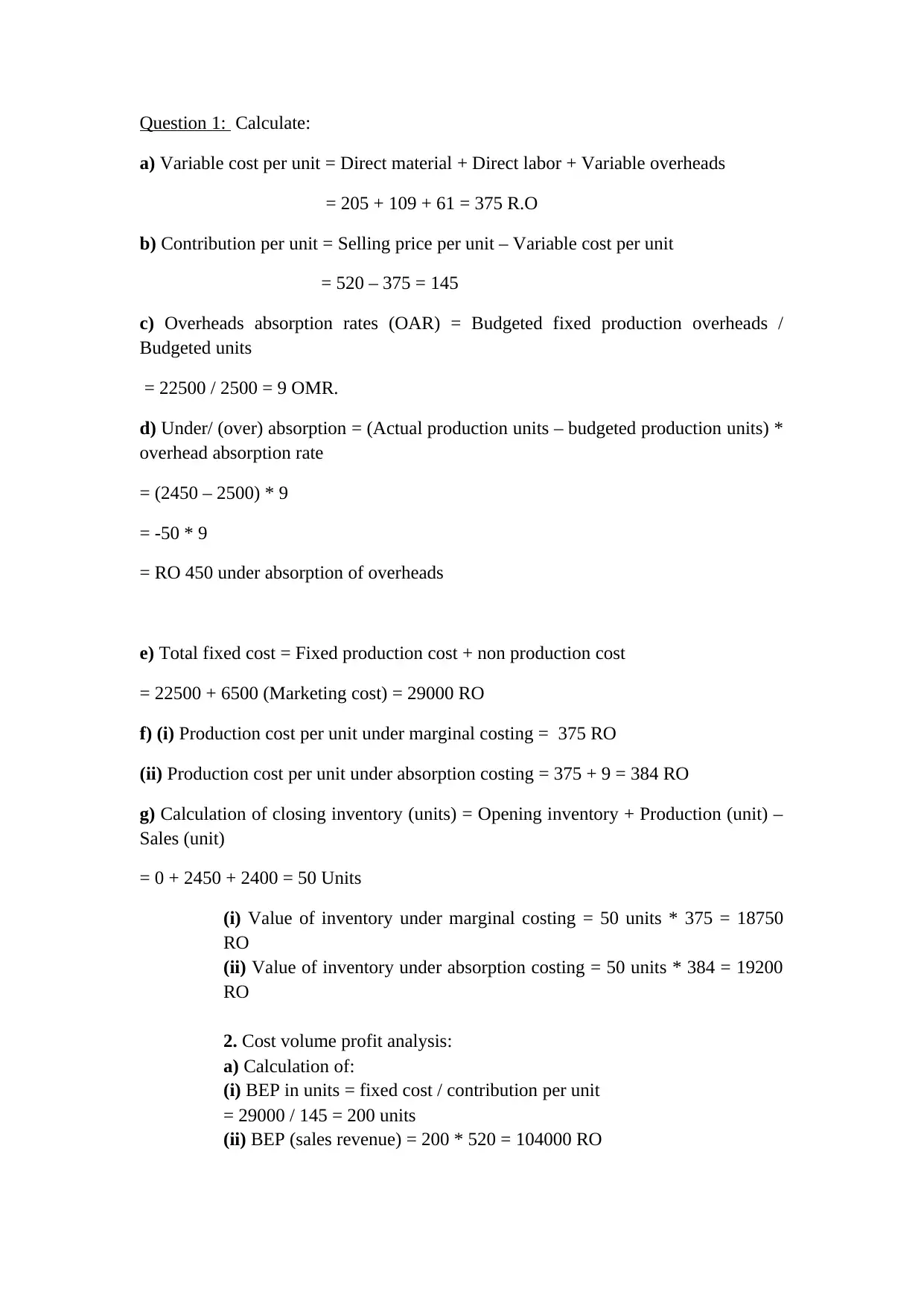
Question 1: Calculate:
a) Variable cost per unit = Direct material + Direct labor + Variable overheads
= 205 + 109 + 61 = 375 R.O
b) Contribution per unit = Selling price per unit – Variable cost per unit
= 520 – 375 = 145
c) Overheads absorption rates (OAR) = Budgeted fixed production overheads /
Budgeted units
= 22500 / 2500 = 9 OMR.
d) Under/ (over) absorption = (Actual production units – budgeted production units) *
overhead absorption rate
= (2450 – 2500) * 9
= -50 * 9
= RO 450 under absorption of overheads
e) Total fixed cost = Fixed production cost + non production cost
= 22500 + 6500 (Marketing cost) = 29000 RO
f) (i) Production cost per unit under marginal costing = 375 RO
(ii) Production cost per unit under absorption costing = 375 + 9 = 384 RO
g) Calculation of closing inventory (units) = Opening inventory + Production (unit) –
Sales (unit)
= 0 + 2450 + 2400 = 50 Units
(i) Value of inventory under marginal costing = 50 units * 375 = 18750
RO
(ii) Value of inventory under absorption costing = 50 units * 384 = 19200
RO
2. Cost volume profit analysis:
a) Calculation of:
(i) BEP in units = fixed cost / contribution per unit
= 29000 / 145 = 200 units
(ii) BEP (sales revenue) = 200 * 520 = 104000 RO
a) Variable cost per unit = Direct material + Direct labor + Variable overheads
= 205 + 109 + 61 = 375 R.O
b) Contribution per unit = Selling price per unit – Variable cost per unit
= 520 – 375 = 145
c) Overheads absorption rates (OAR) = Budgeted fixed production overheads /
Budgeted units
= 22500 / 2500 = 9 OMR.
d) Under/ (over) absorption = (Actual production units – budgeted production units) *
overhead absorption rate
= (2450 – 2500) * 9
= -50 * 9
= RO 450 under absorption of overheads
e) Total fixed cost = Fixed production cost + non production cost
= 22500 + 6500 (Marketing cost) = 29000 RO
f) (i) Production cost per unit under marginal costing = 375 RO
(ii) Production cost per unit under absorption costing = 375 + 9 = 384 RO
g) Calculation of closing inventory (units) = Opening inventory + Production (unit) –
Sales (unit)
= 0 + 2450 + 2400 = 50 Units
(i) Value of inventory under marginal costing = 50 units * 375 = 18750
RO
(ii) Value of inventory under absorption costing = 50 units * 384 = 19200
RO
2. Cost volume profit analysis:
a) Calculation of:
(i) BEP in units = fixed cost / contribution per unit
= 29000 / 145 = 200 units
(ii) BEP (sales revenue) = 200 * 520 = 104000 RO
Paraphrase This Document
Need a fresh take? Get an instant paraphrase of this document with our AI Paraphraser
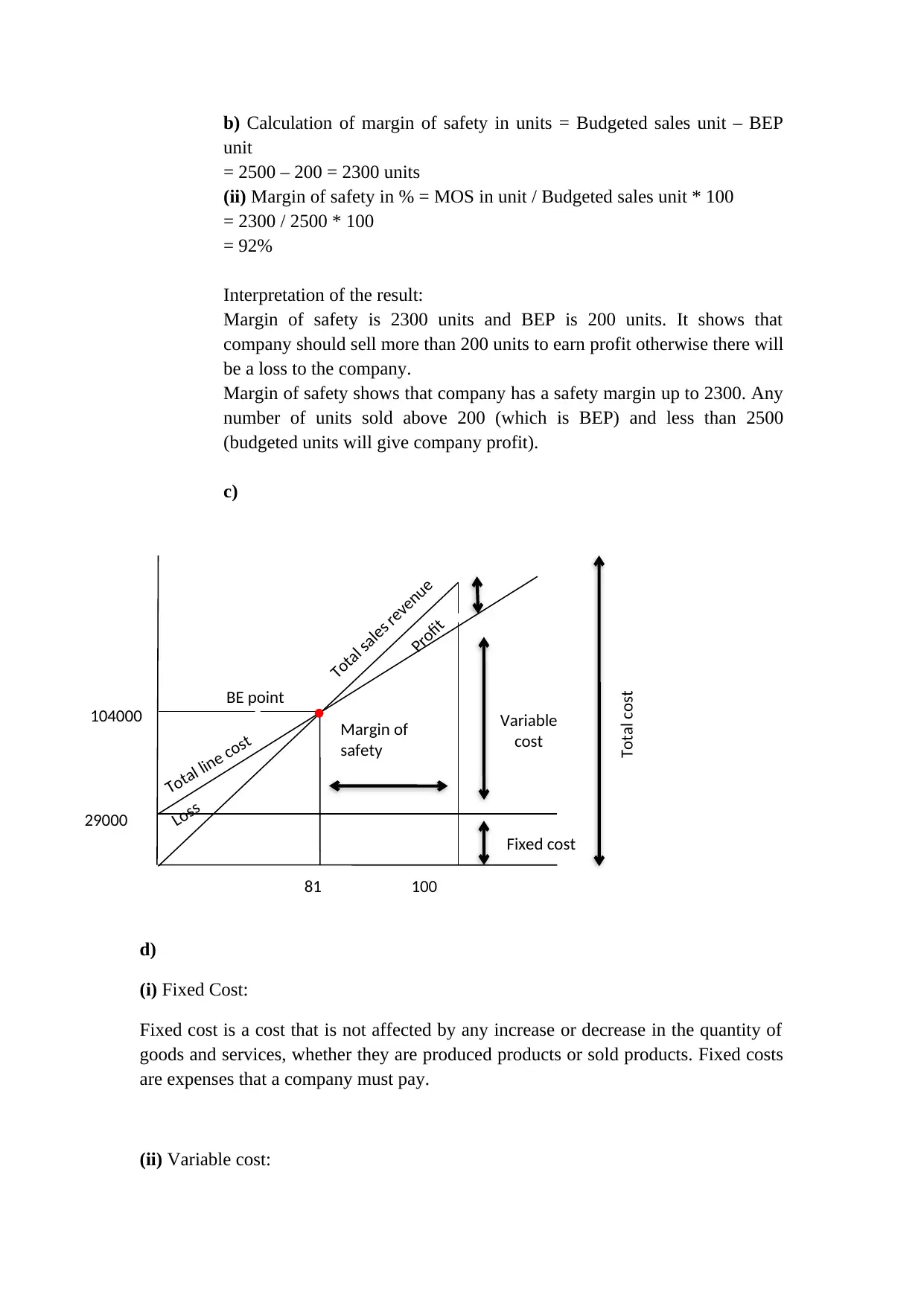
b) Calculation of margin of safety in units = Budgeted sales unit – BEP
unit
= 2500 – 200 = 2300 units
(ii) Margin of safety in % = MOS in unit / Budgeted sales unit * 100
= 2300 / 2500 * 100
= 92%
Interpretation of the result:
Margin of safety is 2300 units and BEP is 200 units. It shows that
company should sell more than 200 units to earn profit otherwise there will
be a loss to the company.
Margin of safety shows that company has a safety margin up to 2300. Any
number of units sold above 200 (which is BEP) and less than 2500
(budgeted units will give company profit).
c)
d)
(i) Fixed Cost:
Fixed cost is a cost that is not affected by any increase or decrease in the quantity of
goods and services, whether they are produced products or sold products. Fixed costs
are expenses that a company must pay.
(ii) Variable cost:
Loss
BE point
81 100
Fixed cost
Variable
cost
Profit
Total sales revenue
Total line cost
29000
104000 Margin of
safety
Total cost
unit
= 2500 – 200 = 2300 units
(ii) Margin of safety in % = MOS in unit / Budgeted sales unit * 100
= 2300 / 2500 * 100
= 92%
Interpretation of the result:
Margin of safety is 2300 units and BEP is 200 units. It shows that
company should sell more than 200 units to earn profit otherwise there will
be a loss to the company.
Margin of safety shows that company has a safety margin up to 2300. Any
number of units sold above 200 (which is BEP) and less than 2500
(budgeted units will give company profit).
c)
d)
(i) Fixed Cost:
Fixed cost is a cost that is not affected by any increase or decrease in the quantity of
goods and services, whether they are produced products or sold products. Fixed costs
are expenses that a company must pay.
(ii) Variable cost:
Loss
BE point
81 100
Fixed cost
Variable
cost
Profit
Total sales revenue
Total line cost
29000
104000 Margin of
safety
Total cost
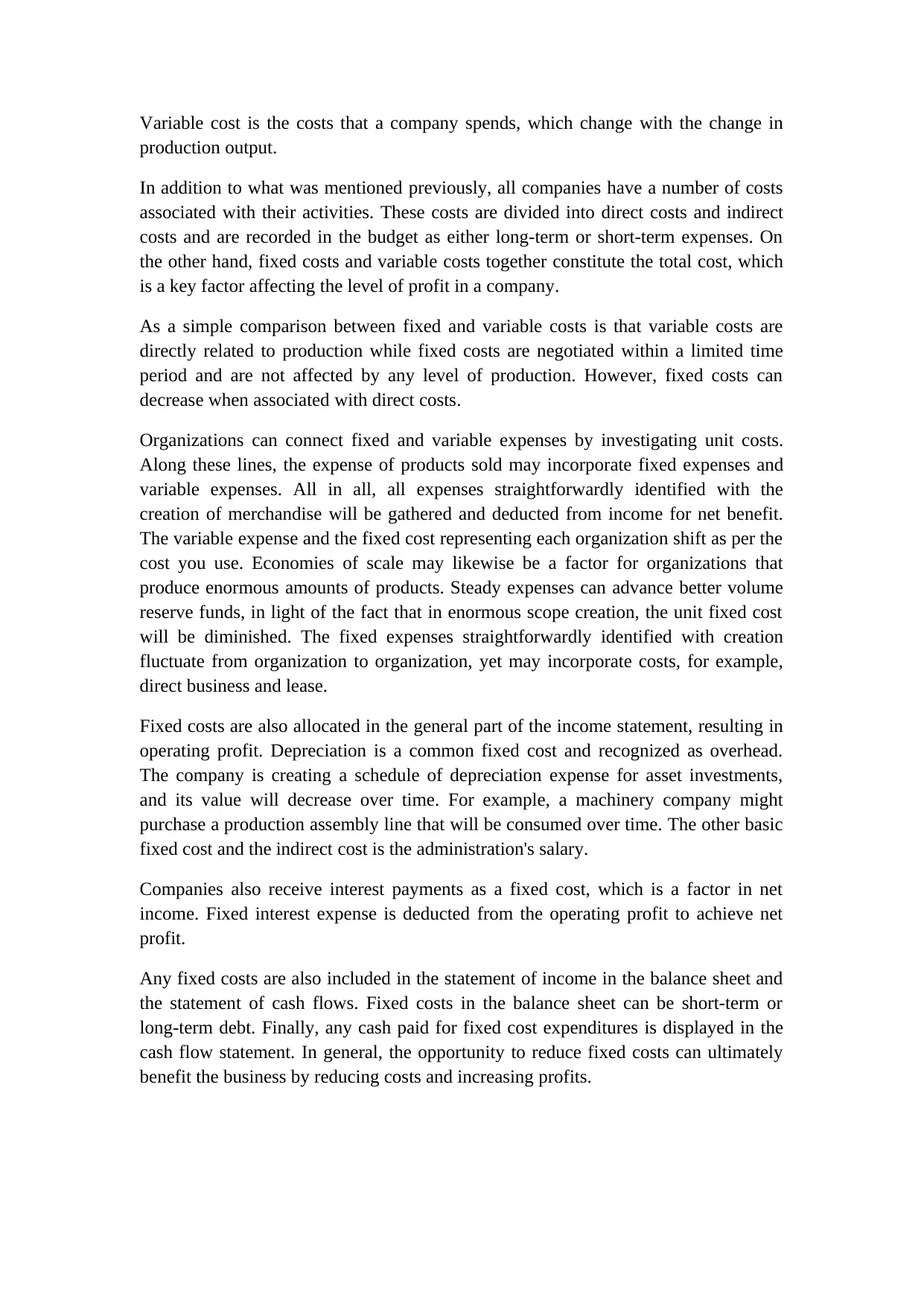
Variable cost is the costs that a company spends, which change with the change in
production output.
In addition to what was mentioned previously, all companies have a number of costs
associated with their activities. These costs are divided into direct costs and indirect
costs and are recorded in the budget as either long-term or short-term expenses. On
the other hand, fixed costs and variable costs together constitute the total cost, which
is a key factor affecting the level of profit in a company.
As a simple comparison between fixed and variable costs is that variable costs are
directly related to production while fixed costs are negotiated within a limited time
period and are not affected by any level of production. However, fixed costs can
decrease when associated with direct costs.
Organizations can connect fixed and variable expenses by investigating unit costs.
Along these lines, the expense of products sold may incorporate fixed expenses and
variable expenses. All in all, all expenses straightforwardly identified with the
creation of merchandise will be gathered and deducted from income for net benefit.
The variable expense and the fixed cost representing each organization shift as per the
cost you use. Economies of scale may likewise be a factor for organizations that
produce enormous amounts of products. Steady expenses can advance better volume
reserve funds, in light of the fact that in enormous scope creation, the unit fixed cost
will be diminished. The fixed expenses straightforwardly identified with creation
fluctuate from organization to organization, yet may incorporate costs, for example,
direct business and lease.
Fixed costs are also allocated in the general part of the income statement, resulting in
operating profit. Depreciation is a common fixed cost and recognized as overhead.
The company is creating a schedule of depreciation expense for asset investments,
and its value will decrease over time. For example, a machinery company might
purchase a production assembly line that will be consumed over time. The other basic
fixed cost and the indirect cost is the administration's salary.
Companies also receive interest payments as a fixed cost, which is a factor in net
income. Fixed interest expense is deducted from the operating profit to achieve net
profit.
Any fixed costs are also included in the statement of income in the balance sheet and
the statement of cash flows. Fixed costs in the balance sheet can be short-term or
long-term debt. Finally, any cash paid for fixed cost expenditures is displayed in the
cash flow statement. In general, the opportunity to reduce fixed costs can ultimately
benefit the business by reducing costs and increasing profits.
production output.
In addition to what was mentioned previously, all companies have a number of costs
associated with their activities. These costs are divided into direct costs and indirect
costs and are recorded in the budget as either long-term or short-term expenses. On
the other hand, fixed costs and variable costs together constitute the total cost, which
is a key factor affecting the level of profit in a company.
As a simple comparison between fixed and variable costs is that variable costs are
directly related to production while fixed costs are negotiated within a limited time
period and are not affected by any level of production. However, fixed costs can
decrease when associated with direct costs.
Organizations can connect fixed and variable expenses by investigating unit costs.
Along these lines, the expense of products sold may incorporate fixed expenses and
variable expenses. All in all, all expenses straightforwardly identified with the
creation of merchandise will be gathered and deducted from income for net benefit.
The variable expense and the fixed cost representing each organization shift as per the
cost you use. Economies of scale may likewise be a factor for organizations that
produce enormous amounts of products. Steady expenses can advance better volume
reserve funds, in light of the fact that in enormous scope creation, the unit fixed cost
will be diminished. The fixed expenses straightforwardly identified with creation
fluctuate from organization to organization, yet may incorporate costs, for example,
direct business and lease.
Fixed costs are also allocated in the general part of the income statement, resulting in
operating profit. Depreciation is a common fixed cost and recognized as overhead.
The company is creating a schedule of depreciation expense for asset investments,
and its value will decrease over time. For example, a machinery company might
purchase a production assembly line that will be consumed over time. The other basic
fixed cost and the indirect cost is the administration's salary.
Companies also receive interest payments as a fixed cost, which is a factor in net
income. Fixed interest expense is deducted from the operating profit to achieve net
profit.
Any fixed costs are also included in the statement of income in the balance sheet and
the statement of cash flows. Fixed costs in the balance sheet can be short-term or
long-term debt. Finally, any cash paid for fixed cost expenditures is displayed in the
cash flow statement. In general, the opportunity to reduce fixed costs can ultimately
benefit the business by reducing costs and increasing profits.
⊘ This is a preview!⊘
Do you want full access?
Subscribe today to unlock all pages.

Trusted by 1+ million students worldwide
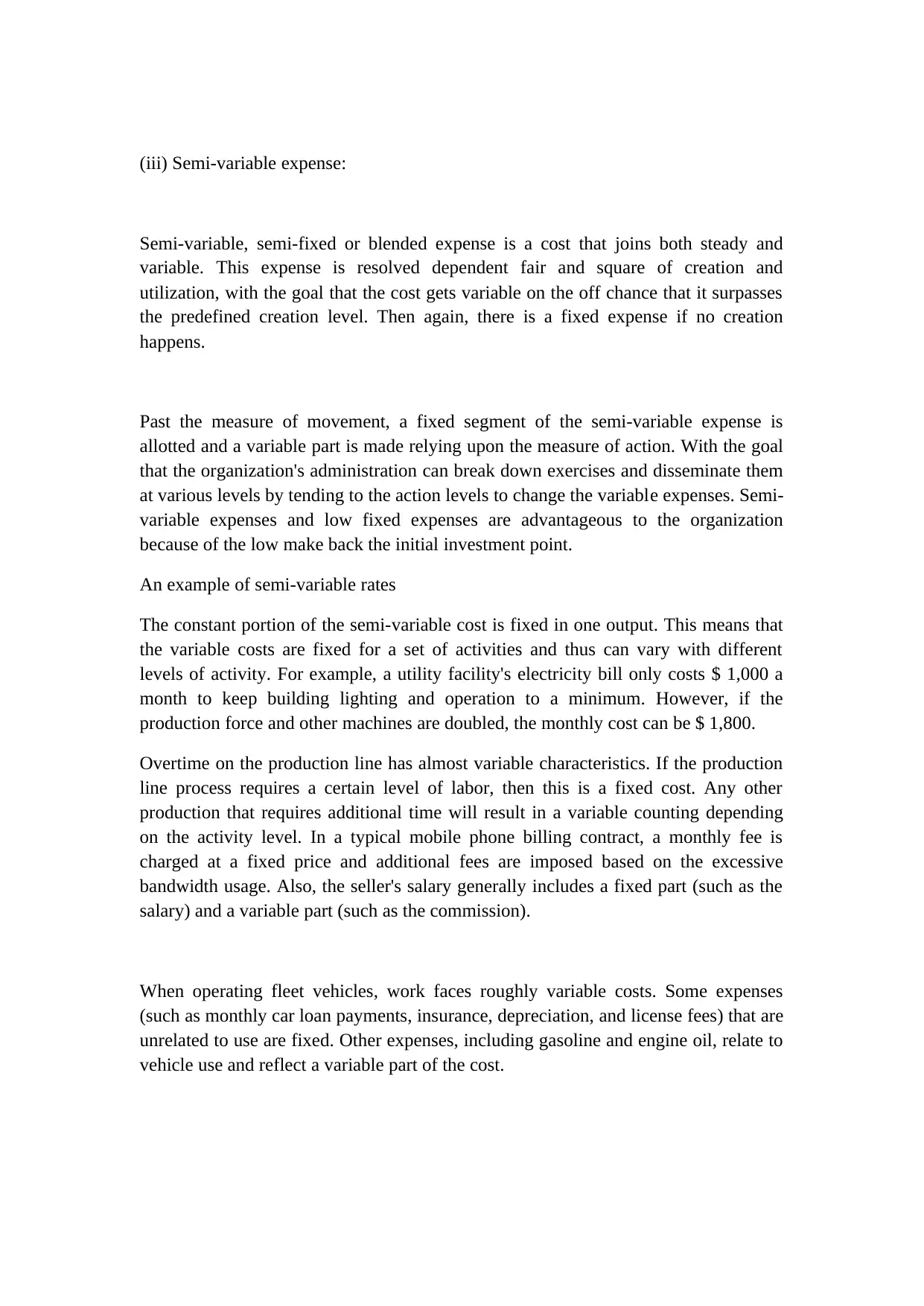
(iii) Semi-variable expense:
Semi-variable, semi-fixed or blended expense is a cost that joins both steady and
variable. This expense is resolved dependent fair and square of creation and
utilization, with the goal that the cost gets variable on the off chance that it surpasses
the predefined creation level. Then again, there is a fixed expense if no creation
happens.
Past the measure of movement, a fixed segment of the semi-variable expense is
allotted and a variable part is made relying upon the measure of action. With the goal
that the organization's administration can break down exercises and disseminate them
at various levels by tending to the action levels to change the variable expenses. Semi-
variable expenses and low fixed expenses are advantageous to the organization
because of the low make back the initial investment point.
An example of semi-variable rates
The constant portion of the semi-variable cost is fixed in one output. This means that
the variable costs are fixed for a set of activities and thus can vary with different
levels of activity. For example, a utility facility's electricity bill only costs $ 1,000 a
month to keep building lighting and operation to a minimum. However, if the
production force and other machines are doubled, the monthly cost can be $ 1,800.
Overtime on the production line has almost variable characteristics. If the production
line process requires a certain level of labor, then this is a fixed cost. Any other
production that requires additional time will result in a variable counting depending
on the activity level. In a typical mobile phone billing contract, a monthly fee is
charged at a fixed price and additional fees are imposed based on the excessive
bandwidth usage. Also, the seller's salary generally includes a fixed part (such as the
salary) and a variable part (such as the commission).
When operating fleet vehicles, work faces roughly variable costs. Some expenses
(such as monthly car loan payments, insurance, depreciation, and license fees) that are
unrelated to use are fixed. Other expenses, including gasoline and engine oil, relate to
vehicle use and reflect a variable part of the cost.
Semi-variable, semi-fixed or blended expense is a cost that joins both steady and
variable. This expense is resolved dependent fair and square of creation and
utilization, with the goal that the cost gets variable on the off chance that it surpasses
the predefined creation level. Then again, there is a fixed expense if no creation
happens.
Past the measure of movement, a fixed segment of the semi-variable expense is
allotted and a variable part is made relying upon the measure of action. With the goal
that the organization's administration can break down exercises and disseminate them
at various levels by tending to the action levels to change the variable expenses. Semi-
variable expenses and low fixed expenses are advantageous to the organization
because of the low make back the initial investment point.
An example of semi-variable rates
The constant portion of the semi-variable cost is fixed in one output. This means that
the variable costs are fixed for a set of activities and thus can vary with different
levels of activity. For example, a utility facility's electricity bill only costs $ 1,000 a
month to keep building lighting and operation to a minimum. However, if the
production force and other machines are doubled, the monthly cost can be $ 1,800.
Overtime on the production line has almost variable characteristics. If the production
line process requires a certain level of labor, then this is a fixed cost. Any other
production that requires additional time will result in a variable counting depending
on the activity level. In a typical mobile phone billing contract, a monthly fee is
charged at a fixed price and additional fees are imposed based on the excessive
bandwidth usage. Also, the seller's salary generally includes a fixed part (such as the
salary) and a variable part (such as the commission).
When operating fleet vehicles, work faces roughly variable costs. Some expenses
(such as monthly car loan payments, insurance, depreciation, and license fees) that are
unrelated to use are fixed. Other expenses, including gasoline and engine oil, relate to
vehicle use and reflect a variable part of the cost.
Paraphrase This Document
Need a fresh take? Get an instant paraphrase of this document with our AI Paraphraser
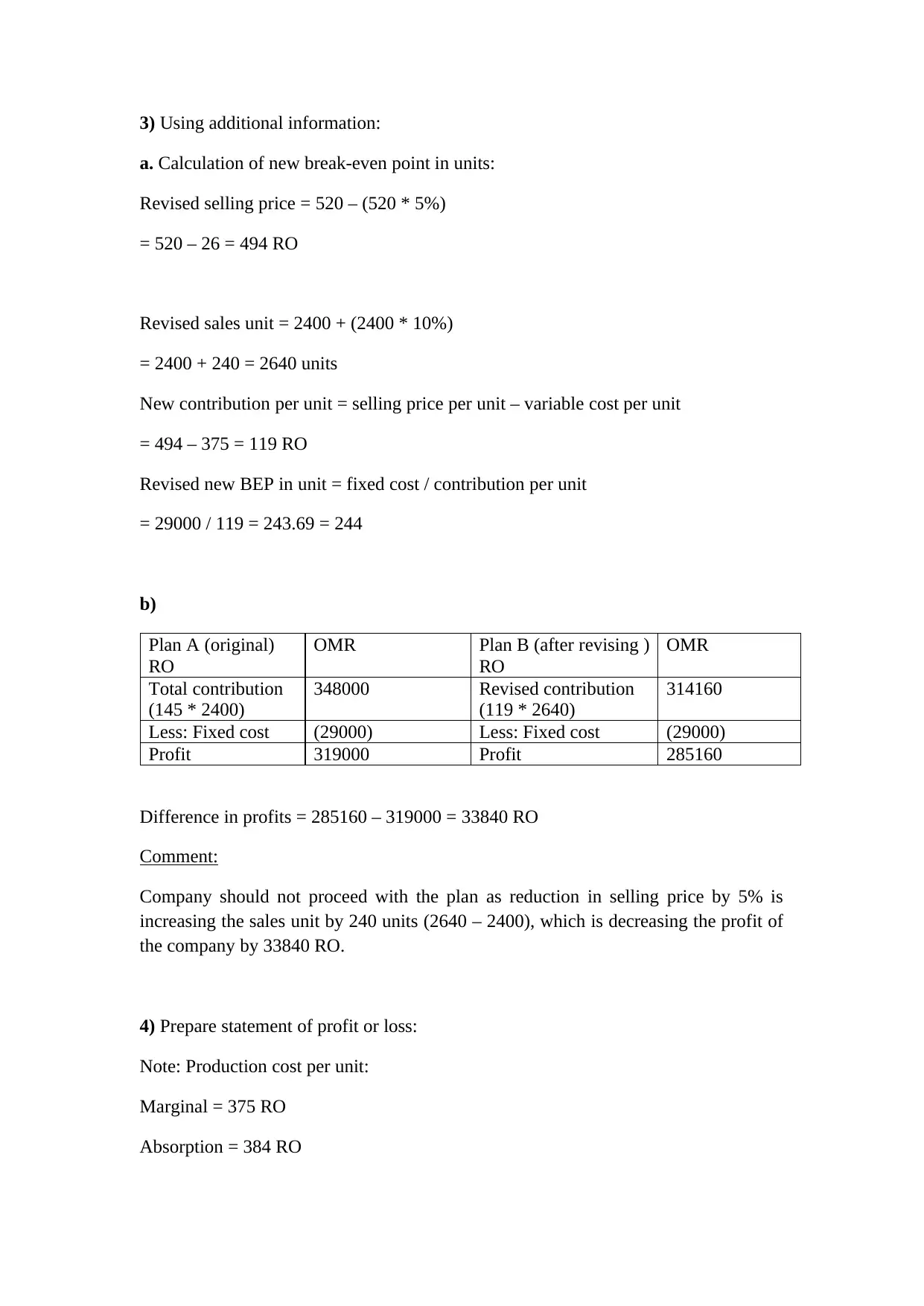
3) Using additional information:
a. Calculation of new break-even point in units:
Revised selling price = 520 – (520 * 5%)
= 520 – 26 = 494 RO
Revised sales unit = 2400 + (2400 * 10%)
= 2400 + 240 = 2640 units
New contribution per unit = selling price per unit – variable cost per unit
= 494 – 375 = 119 RO
Revised new BEP in unit = fixed cost / contribution per unit
= 29000 / 119 = 243.69 = 244
b)
OMRPlan B (after revising )
RO
OMRPlan A (original)
RO
314160Revised contribution
(119 * 2640)
348000Total contribution
(145 * 2400)
(29000)Less: Fixed cost(29000)Less: Fixed cost
285160Profit319000Profit
Difference in profits = 285160 – 319000 = 33840 RO
Comment:
Company should not proceed with the plan as reduction in selling price by 5% is
increasing the sales unit by 240 units (2640 – 2400), which is decreasing the profit of
the company by 33840 RO.
4) Prepare statement of profit or loss:
Note: Production cost per unit:
Marginal = 375 RO
Absorption = 384 RO
a. Calculation of new break-even point in units:
Revised selling price = 520 – (520 * 5%)
= 520 – 26 = 494 RO
Revised sales unit = 2400 + (2400 * 10%)
= 2400 + 240 = 2640 units
New contribution per unit = selling price per unit – variable cost per unit
= 494 – 375 = 119 RO
Revised new BEP in unit = fixed cost / contribution per unit
= 29000 / 119 = 243.69 = 244
b)
OMRPlan B (after revising )
RO
OMRPlan A (original)
RO
314160Revised contribution
(119 * 2640)
348000Total contribution
(145 * 2400)
(29000)Less: Fixed cost(29000)Less: Fixed cost
285160Profit319000Profit
Difference in profits = 285160 – 319000 = 33840 RO
Comment:
Company should not proceed with the plan as reduction in selling price by 5% is
increasing the sales unit by 240 units (2640 – 2400), which is decreasing the profit of
the company by 33840 RO.
4) Prepare statement of profit or loss:
Note: Production cost per unit:
Marginal = 375 RO
Absorption = 384 RO
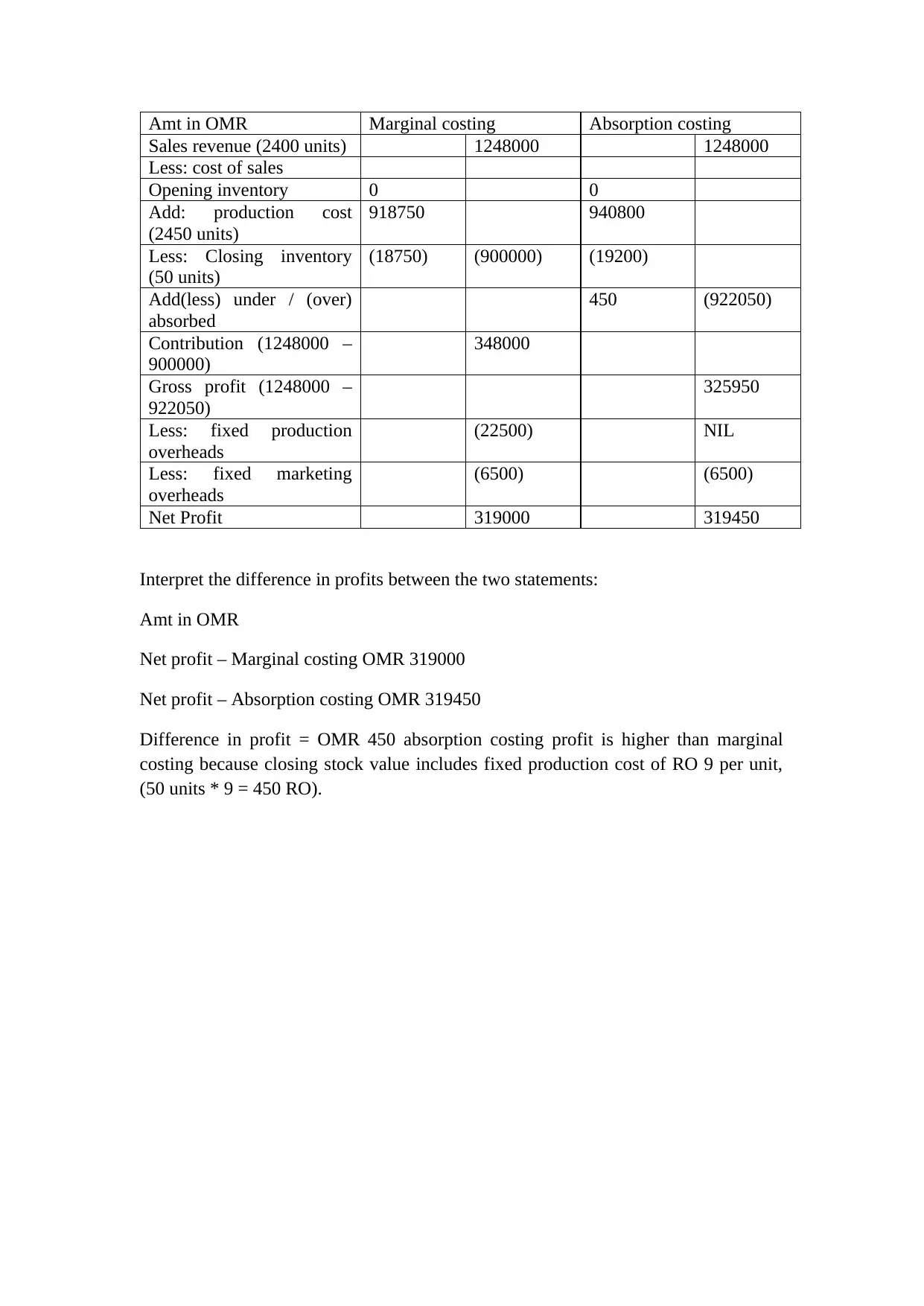
Absorption costingMarginal costingAmt in OMR
12480001248000Sales revenue (2400 units)
Less: cost of sales
00Opening inventory
940800918750Add: production cost
(2450 units)
(19200)(900000)(18750)Less: Closing inventory
(50 units)
(922050)450Add(less) under / (over)
absorbed
348000Contribution (1248000 –
900000)
325950Gross profit (1248000 –
922050)
NIL(22500)Less: fixed production
overheads
(6500)(6500)Less: fixed marketing
overheads
319450319000Net Profit
Interpret the difference in profits between the two statements:
Amt in OMR
Net profit – Marginal costing OMR 319000
Net profit – Absorption costing OMR 319450
Difference in profit = OMR 450 absorption costing profit is higher than marginal
costing because closing stock value includes fixed production cost of RO 9 per unit,
(50 units * 9 = 450 RO).
12480001248000Sales revenue (2400 units)
Less: cost of sales
00Opening inventory
940800918750Add: production cost
(2450 units)
(19200)(900000)(18750)Less: Closing inventory
(50 units)
(922050)450Add(less) under / (over)
absorbed
348000Contribution (1248000 –
900000)
325950Gross profit (1248000 –
922050)
NIL(22500)Less: fixed production
overheads
(6500)(6500)Less: fixed marketing
overheads
319450319000Net Profit
Interpret the difference in profits between the two statements:
Amt in OMR
Net profit – Marginal costing OMR 319000
Net profit – Absorption costing OMR 319450
Difference in profit = OMR 450 absorption costing profit is higher than marginal
costing because closing stock value includes fixed production cost of RO 9 per unit,
(50 units * 9 = 450 RO).
⊘ This is a preview!⊘
Do you want full access?
Subscribe today to unlock all pages.

Trusted by 1+ million students worldwide
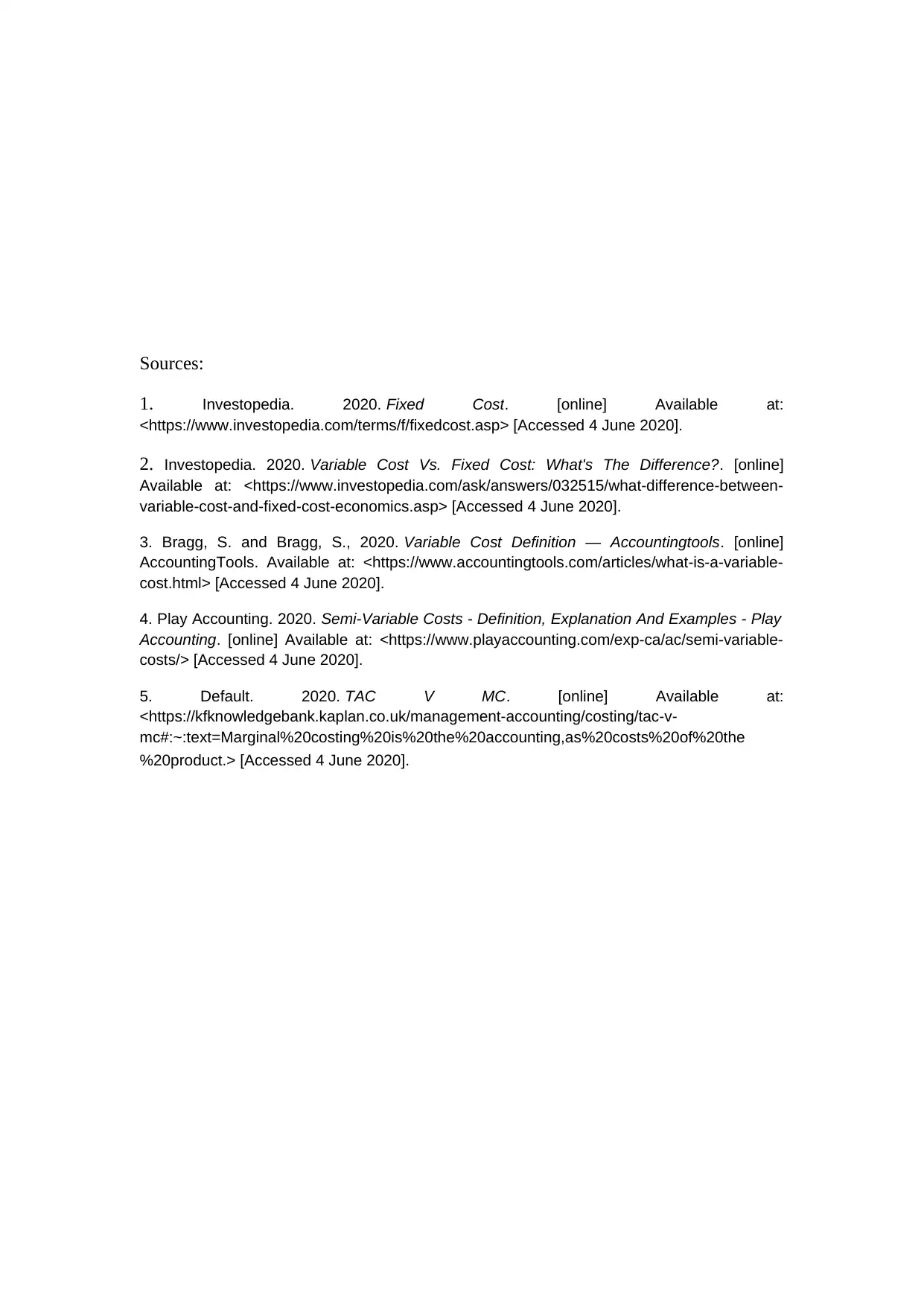
Sources:
1. Investopedia. 2020. Fixed Cost. [online] Available at:
<https://www.investopedia.com/terms/f/fixedcost.asp> [Accessed 4 June 2020].
2. Investopedia. 2020. Variable Cost Vs. Fixed Cost: What's The Difference?. [online]
Available at: <https://www.investopedia.com/ask/answers/032515/what-difference-between-
variable-cost-and-fixed-cost-economics.asp> [Accessed 4 June 2020].
3. Bragg, S. and Bragg, S., 2020. Variable Cost Definition — Accountingtools. [online]
AccountingTools. Available at: <https://www.accountingtools.com/articles/what-is-a-variable-
cost.html> [Accessed 4 June 2020].
4. Play Accounting. 2020. Semi-Variable Costs - Definition, Explanation And Examples - Play
Accounting. [online] Available at: <https://www.playaccounting.com/exp-ca/ac/semi-variable-
costs/> [Accessed 4 June 2020].
5. Default. 2020. TAC V MC. [online] Available at:
<https://kfknowledgebank.kaplan.co.uk/management-accounting/costing/tac-v-
mc#:~:text=Marginal%20costing%20is%20the%20accounting,as%20costs%20of%20the
%20product.> [Accessed 4 June 2020].
1. Investopedia. 2020. Fixed Cost. [online] Available at:
<https://www.investopedia.com/terms/f/fixedcost.asp> [Accessed 4 June 2020].
2. Investopedia. 2020. Variable Cost Vs. Fixed Cost: What's The Difference?. [online]
Available at: <https://www.investopedia.com/ask/answers/032515/what-difference-between-
variable-cost-and-fixed-cost-economics.asp> [Accessed 4 June 2020].
3. Bragg, S. and Bragg, S., 2020. Variable Cost Definition — Accountingtools. [online]
AccountingTools. Available at: <https://www.accountingtools.com/articles/what-is-a-variable-
cost.html> [Accessed 4 June 2020].
4. Play Accounting. 2020. Semi-Variable Costs - Definition, Explanation And Examples - Play
Accounting. [online] Available at: <https://www.playaccounting.com/exp-ca/ac/semi-variable-
costs/> [Accessed 4 June 2020].
5. Default. 2020. TAC V MC. [online] Available at:
<https://kfknowledgebank.kaplan.co.uk/management-accounting/costing/tac-v-
mc#:~:text=Marginal%20costing%20is%20the%20accounting,as%20costs%20of%20the
%20product.> [Accessed 4 June 2020].
1 out of 7
Related Documents
Your All-in-One AI-Powered Toolkit for Academic Success.
+13062052269
info@desklib.com
Available 24*7 on WhatsApp / Email
![[object Object]](/_next/static/media/star-bottom.7253800d.svg)
Unlock your academic potential
Copyright © 2020–2025 A2Z Services. All Rights Reserved. Developed and managed by ZUCOL.





